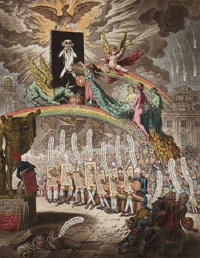
The Yale Center for British Art is hosting an exhibition about an obscure 18th-century art hoax (one that I had never heard of before). The exhibition is titled "Benjamin West and the Venetian Secret" -- which makes it sound a bit like a new Harry Potter novel. From
Art Knowledge News:
In 1796 Benjamin West, the American-born President of the Royal Academy of Arts in London, fell victim to a remarkable fraud. A shadowy figure, Thomas Provis, and his artist daughter, Ann Jemima Provis, persuaded West that they possessed a copy of an old manuscript purporting to contain descriptions of materials and techniques used by the Venetian painters of the High Renaissance, including Titian, to achieve the famously luminous effects of color that had long been thought lost, forgotten, or shrouded in secrecy. West experimented with these materials and techniques and used them to execute a history painting entitled Cicero Discovering the Tomb of Archimedes (1796–97). In truth the manuscript was fake and the story an absurd invention. West had believed it, and, through him, the Provises managed to dupe a number of other key artist-Academicians.
When the fraud was finally exposed, the embarrassment was far worse for West than it was for the other victims. It was largely through his influential position as President of the Royal Academy that the perpetrators gained access to so many of his variously hapless, dim-witted, or simply greedy colleagues. Years later, having been mercilessly held up to ridicule by satirists (in song; in the press; and in a remarkable satirical engraving titled Titianus Redivivus by James Gillray, 1797,Benjamin West - Cicero Discovering the Tomb of Archimedes, 1796–97, Oil on canvas - Collection of Mr. & Mrs. Michael D. Eisner. West painted an almost identical version of Cicero Discovering the Tomb of Archimedes (1804), this time according to his own methods and traditional studio practices. This “atonement” painting is today in the collection of the Yale University Art Gallery.

 The Yale Center for British Art is hosting an exhibition about an obscure 18th-century art hoax (one that I had never heard of before). The exhibition is titled "Benjamin West and the Venetian Secret" -- which makes it sound a bit like a new Harry Potter novel. From Art Knowledge News:
The Yale Center for British Art is hosting an exhibition about an obscure 18th-century art hoax (one that I had never heard of before). The exhibition is titled "Benjamin West and the Venetian Secret" -- which makes it sound a bit like a new Harry Potter novel. From Art Knowledge News:
Comments
Benjamin West was, of course, one of the most prominent and influential artists of his day, at least in Britain. The scandal was not just that various famous artists had fallen for a fake manuscript, but that when the instructions in the manuscript were followed (Ann Provis also gave private lessons in the method), the resulting paintings did not reproduce the look of the Renaissance masters' works at all.
The formulae in the manuscript called for chemicals and pigments that were unknown until the 17th and 18th centuries. It was as if someone now were to say you could make an exact reproduction of ancient Roman armor using Kevlar, titanium alloys, and Teflon.
Note: The Art Knowledge News article that is linked to here has the picture captions switched. What is identified as West's painting is really Gillray's satirical cartoon, and vice versa.